With a 200 mile commercial fishing exclusion zone for all foreign vessels, plus sensible conservation measures applying to their own commercial fleet, Iceland has natural fish stocks that are the envy of the rest of the World.
Although the boat fishing has been highlighted in the angling press over the past few years with some major international competitions held in the country, the shore fishing has gone relatively unnoticed. It stands to reason though, that with the strict conservation policies and the massive exclusion zone in place inshore fish stocks are bound to be brilliant. The anonymity of the shore fishing is about to change!
Steve Mason, a Geordie, professional fish filleter and keen shore angler found himself working in Iceland and immediately started to look at the shore fishing potential. It comes as no surprise, that in comparison to the UK, his catches were staggering with double figure cod, big haddock, catfish and plaice commonplace.
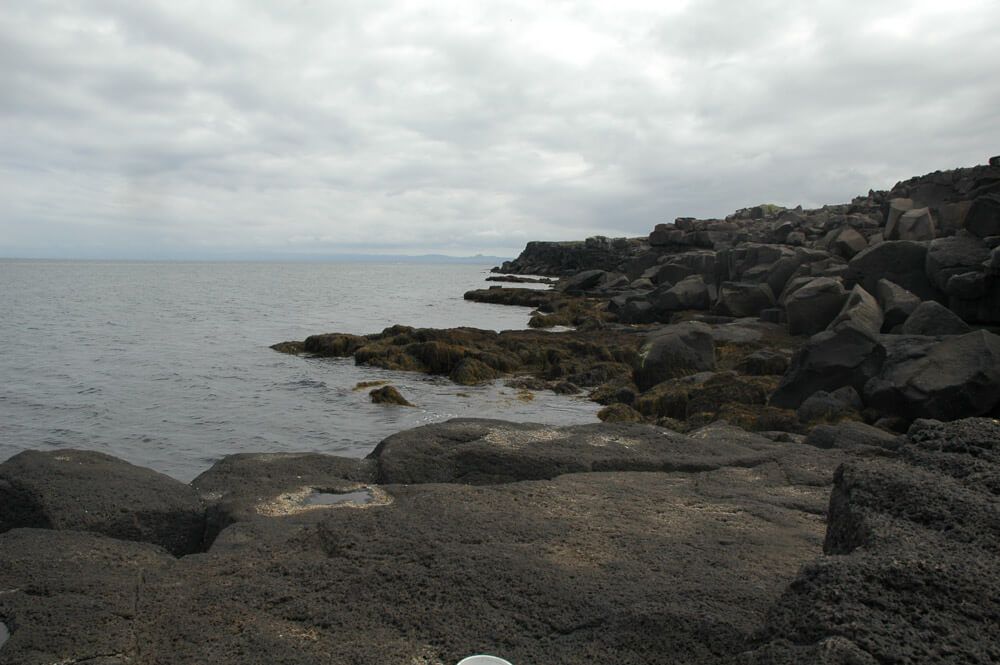
An invite from Steve to check the fishing out saw Barney Wright of TSF magazine, top tournament caster Pete Thain and WSF’s Mike Thrussell flying in to the Icelandic capital Reykjavik to see for themselves just how good the fishing is.
FULL ON FISHING!
Within a couple of hours of the plane landing and dropping our gear off at the digs, we were in the car and heading for some rock ledges near to the little town of Reykjanesbaer south of the capital.
The rock ledges were fairly flat but drop in to deep water quickly. Still in a UK mindset we all cast baits out as far as we could and propped the rods in makeshift rod rests expecting to wait a while for the first bites. Immediately as the baits hit bottom the fish were on them. Fat haddock over 2lbs and big whiting! Though all experienced anglers none of us had caught haddock from the shore before, so what a way to start!
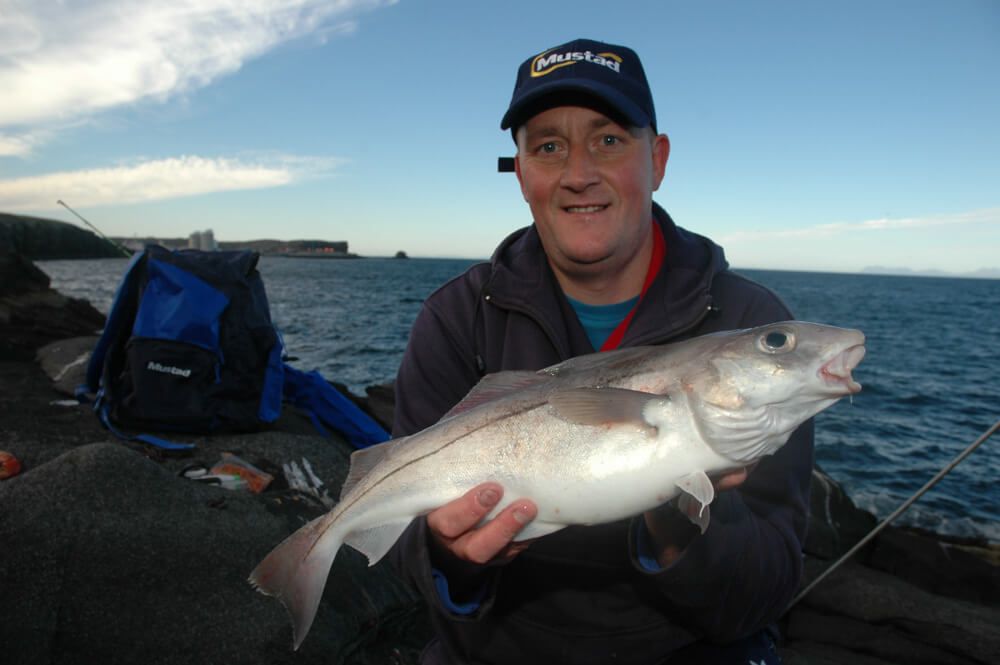
Switching over to a big lug bait tipped with mussel I put some real power behind the cast. Within a minute the rod top animated and as I struck I felt the head shake of a cod. A fat little fish around the 4lb mark that I slipped straight back in to the water.
The fish just kept coming with all of us building up impressive bags of codling, whiting, dabs and haddock.
The next target fish were the coalfish, but we intended to target these with the fly rods. Setting up 10-weights with fast sinking lines and weighted flies we were soon hitting coalies up to 2lbs that fought like demons in the deep water. Fast stripping the flies up from the depths yielded fish after fish until your arms ached. With a little more reconnaissance put in I’m sure there are double figure coalies to be caught on the fly here, as well as with the spinning rod.
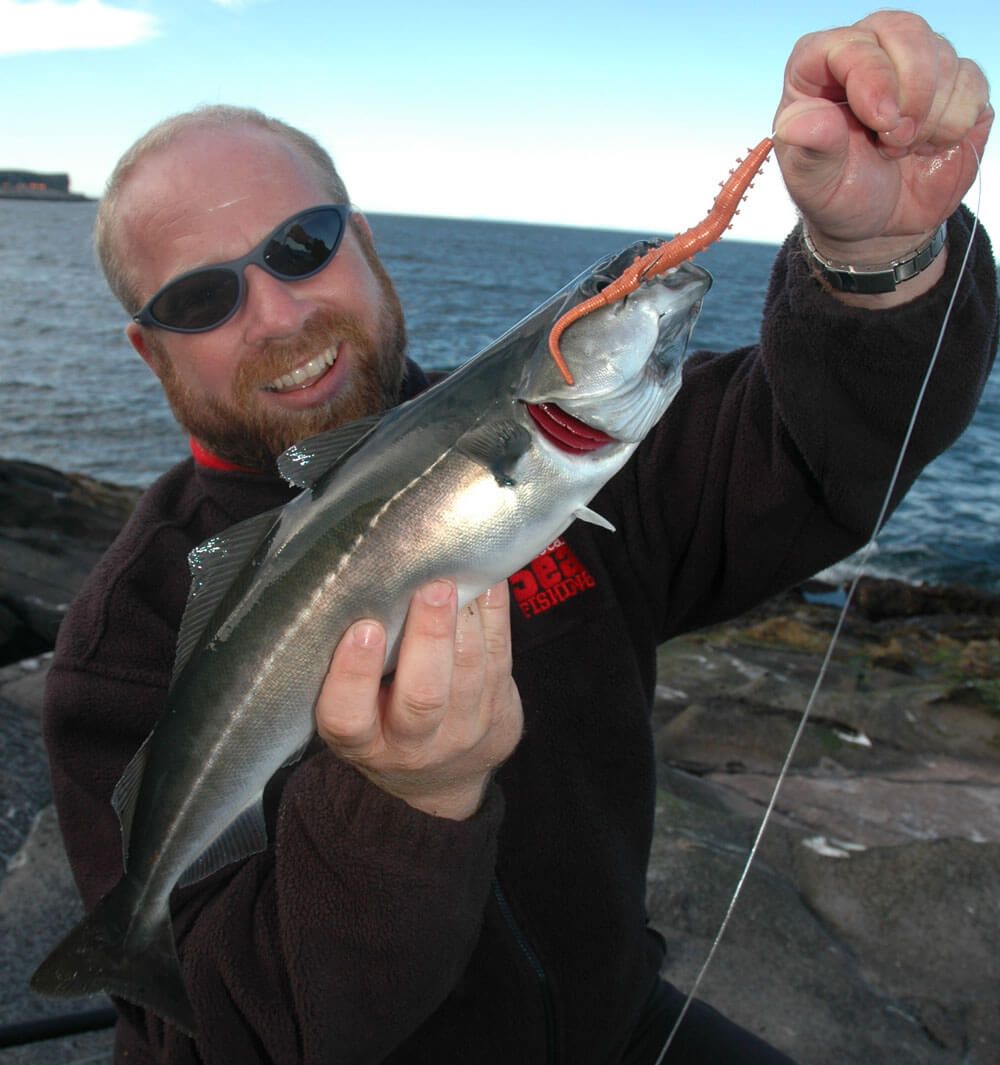
The second day saw us fishing a pier just to the west of the same town. This again gives access to deep water, mainly sand with rock patches. The pier is popular with local anglers and is very productive.
This instantly proved a good cod venue with several fish around the 6 to 7lb mark, some big dabs, haddock by the ton, dabs, coalfish and huge scorpion fish. We enjoyed a second session on this mark with even better catches.
I started off with a quartet of cod up to 8lbs just casting out from the right hand side. Barney was next in with a nice 6lber, and Pete followed up with a fish about the same size. Barney’s next bite was a much better fish that hung out deep, shaking its head and taking line. Barney eased it ever shorewards and a fit and fat looking 12lber dropped on to the pier planks…our best cod of the trip. Pete then banged a long cast way out and hooked a beautiful looking small arctic starry ray.
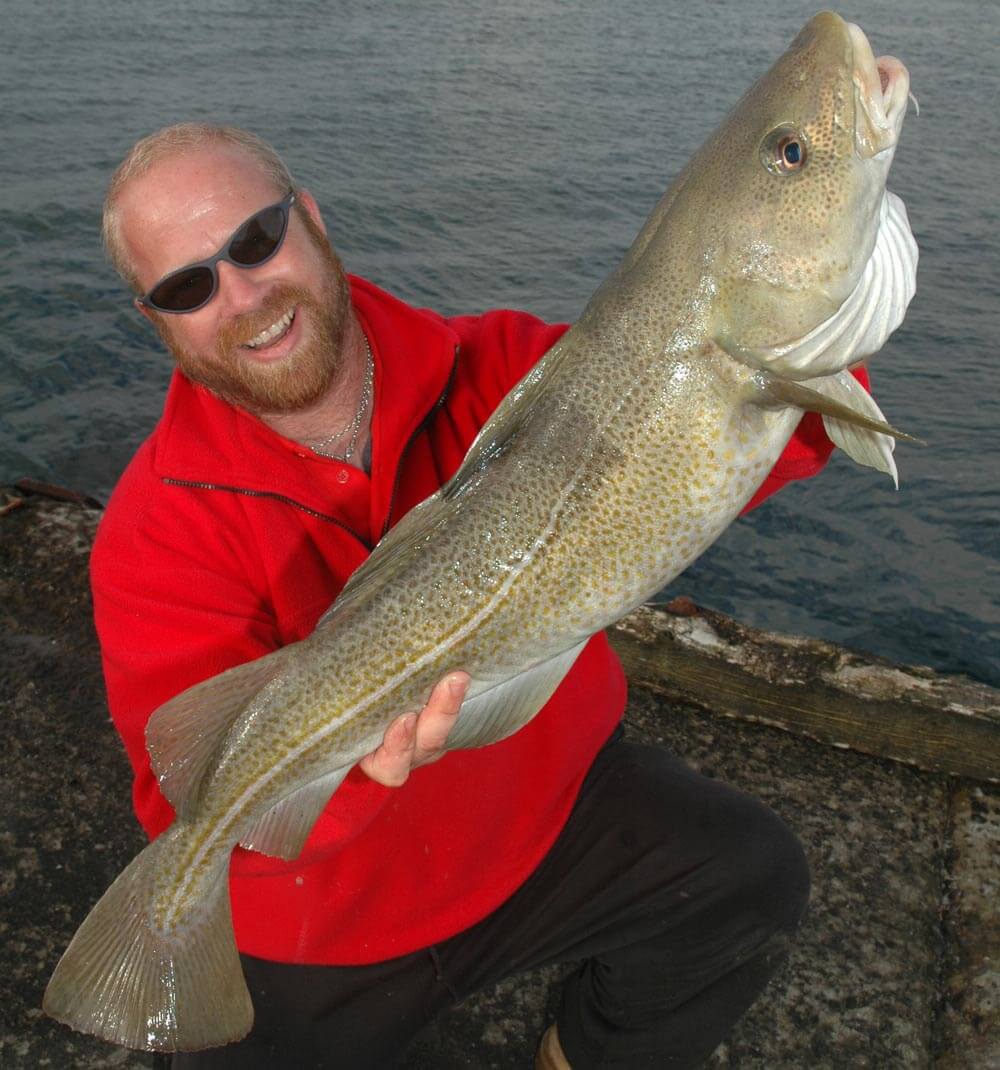
Starting to experiment a little more now, I switched to a three-hook rig with size 2 Partridge Match hooks and landed two plaice amongst a succession of big dabs and whiting. The plaice have been caught here to a stonking 8lbs, but inshore plaice can run in to double figures but have never been targeted off the shore by anglers, so who knows what size they actually reach.
TON UP FISHING
Steve was keen to fish an area of very rough ground that we all felt should give us a better chance of big cod. We paired off, Pete and Steve off to the left, Barney and I to the right and about 100 yards away.
We were in trouble straight away when even with 30lb line and 60lb shock leaders using rotten bottom rigs we couldn’t get our gear back over sheer subterranean rock ledges out in front of us. We both hooked and lost good fish, but apart from landing a couple of haddock we just could not get back over the snags.
The other lads were doing much better though over slightly easier ground. A shout from them saw us scurrying over to see Steve battling it out with a fish eager to stay out in the deeper water. Slowly but surely the fish came in and what a shock for all us to see a incredible 15lb torsk, a fish normally associated with offshore deep water wrecks, slide in on to the rocks. A fish of a lifetime in anybody’s book!
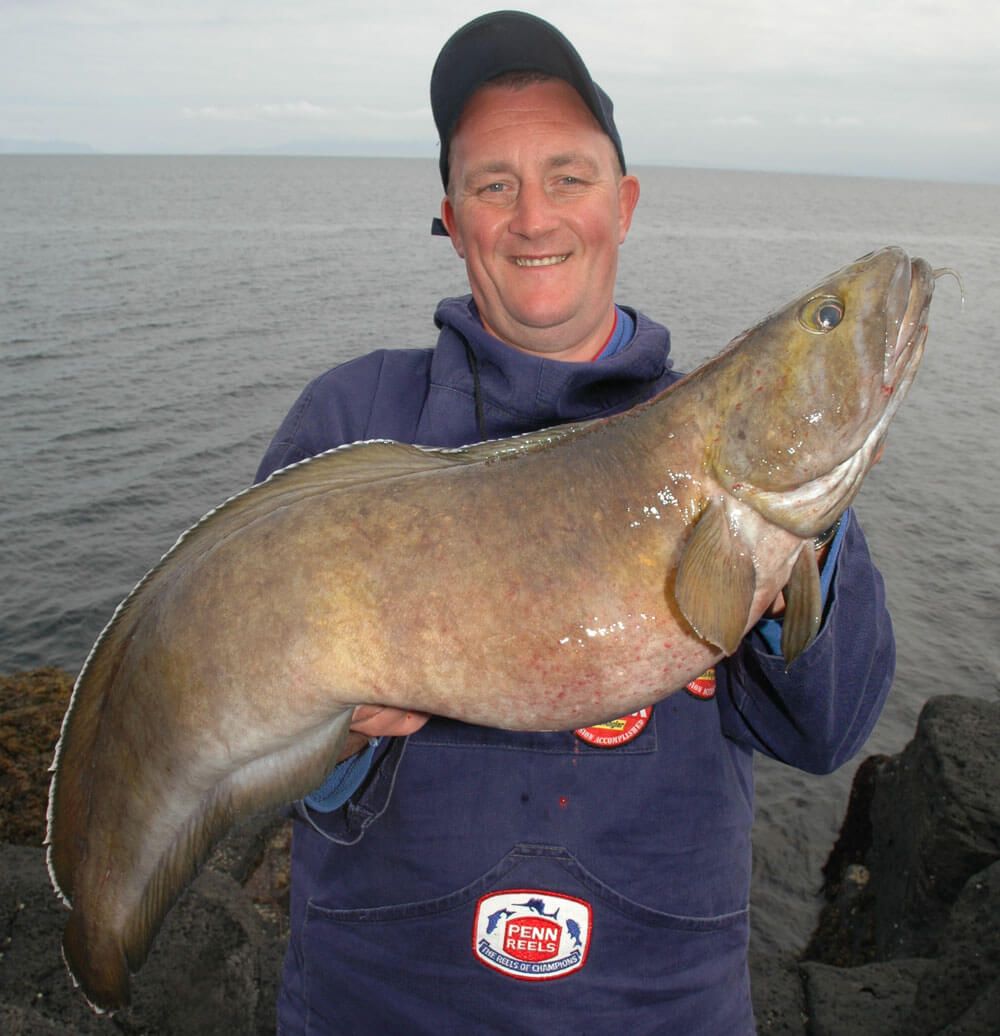
Pete had been catching codling, whiting, ling and haddock steadily, but then struck a bite that looked different and produced a cracking looking lemon sole over 2lbs. Pete, though capable of putting baits massive distances out, was just lobbing his rigs 80yds or so as it may no difference to the quality or quantity of fish caught, the sea was just teeming with fish!
Deciding on a change of mark, we headed west again to fish rock ledges just east of a small harbour. Steve knew I was keen to catch a catfish, sometimes called a wolffish here in the UK, and said this mark would give me my best shot.
Baiting up with clam and mussel cocktails, a put a plain lead on, cast out about 100yds, and let the lead swing round with the tide run. The idea was to try and find an area of rock which is where the cats tend to live. Eventually, I found the rocks and kept putting baits directly on to it.
After a half hour or so I got the bite I wanted. The fish banged on the rod tip and kept low to the ground before coming up in the water and making head shaking about turns trying to take line and head back for the bottom. The fish broke surface and I knew I’d got my cat. It weighed just 5lb 6ozs, but fought like a double figure fish and sported savage looking fang like teeth. The cat was a special fish for me as it was my 100th different species from eastern Atlantic waters.
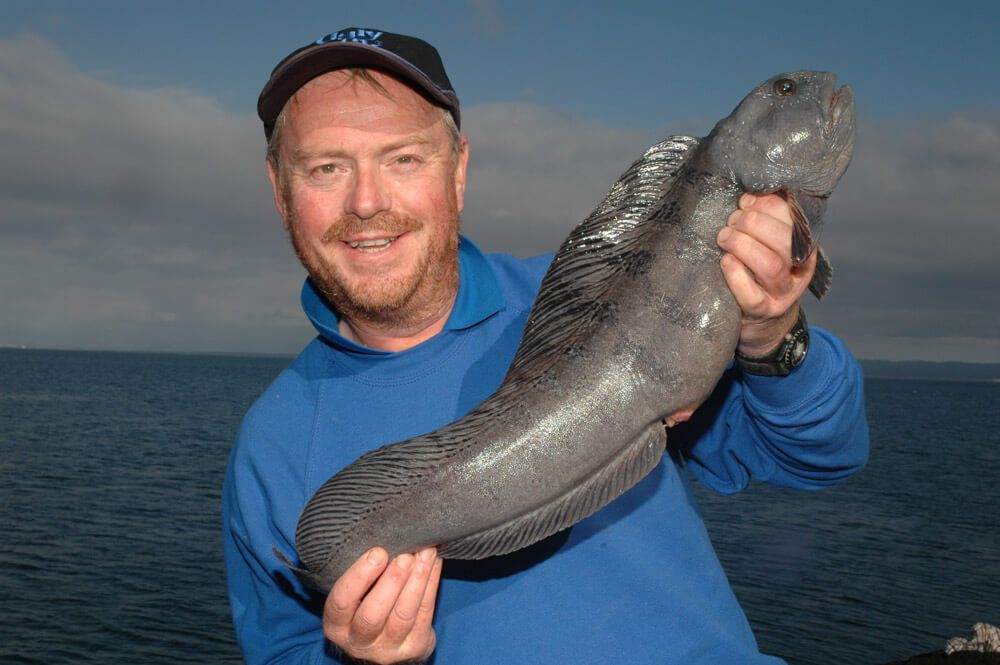
This mark was also alive with haddock. So much so that fishing three-hook rigs we were getting three haddock each and every cast with some of those haddock genuine 3lb fish.
It was three very sad anglers that packed their gear away for the last time ready for the journey home. Iceland made a massive impression on all of us and we all vowed to return. I’m already looking forward to a return trip in April 07 to fish with Steve and Pete again.
TACKLING UP
Basically you need typical UK rough ground rods and reels. Stiff 5-6oz beachcasters, Penn 525’s loaded with 20lb line for cleaner ground work, and bigger 545’s with 30lb line are good choices, as would an old style ABU 9000 with 30lb line, or ABU 7000’s with 25lb line.
The best rigs are pulley rigs made from 60 to 80lb mono with 40lb hook links. For the cod, cats etc use two-hook 4/0 Pennel systems made with 4/0 to 6/0 Partridge Sting Point hooks or Mustad Vikings.
For smaller species you can’t beat simple three-hook flappers with size 2 Aberdeen hooks.
Take good climbing boots, not waders or chesties. Good sunglasses are essential as the light can be intense at times due to good air clarity.
BAITING UP
Just like the fish, bait stocks are excellent and easy to collect. There are extensive lug beds in most of the sheltered bays, also big sand clams and huge mussels, the biggest I’ve ever seen. These are the staple baits and highly effective for all species.
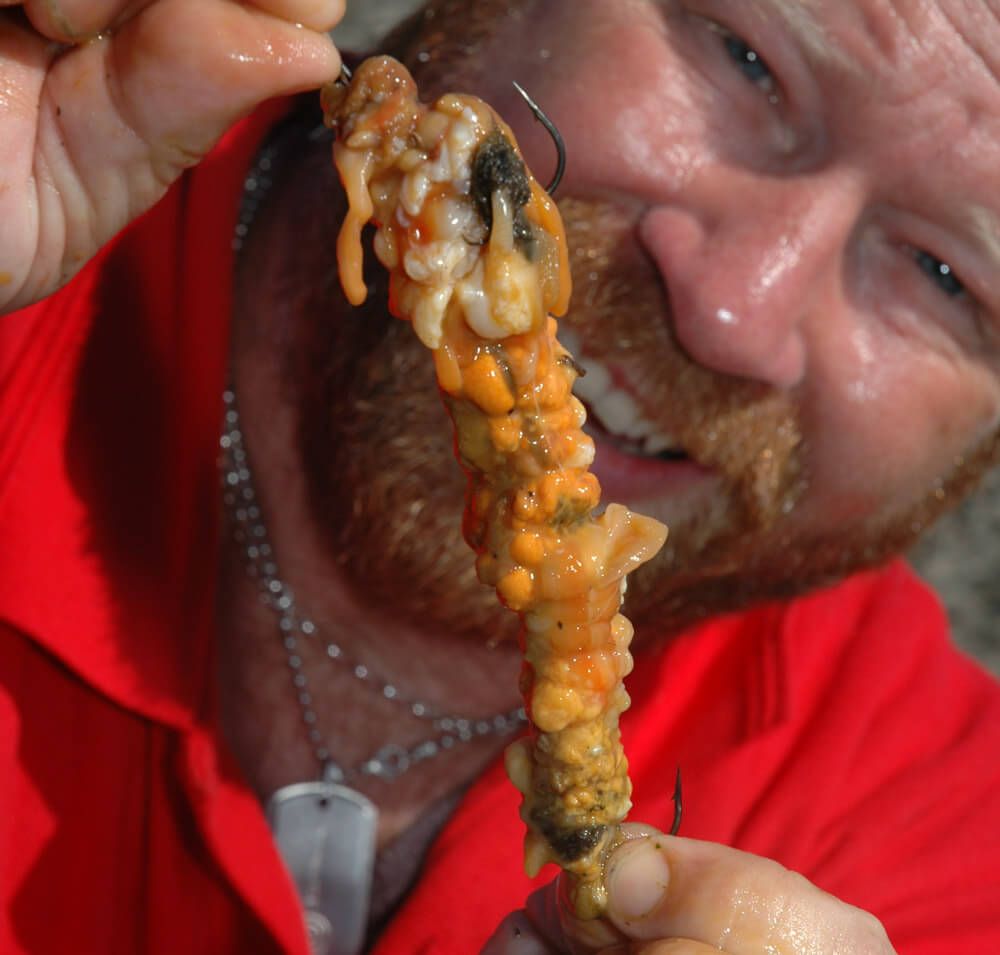
Fish baits also work well, especially oily fish like herring etc. That said most baits get scoffed immediately they hit the bottom, as with so many fish competing for food they can’t afford to be choosy.
CONCLUSION
Awesome! That’s the only word I can use that gives you some idea of just how good the fishing is, and apparently wee didn’t see anywhere near the best of it according to Steve who was genuinely disappointed we hadn’t hit a 20lb cod between us. Bearing in mind too that we only fished three days all in.
It’s my opinion that the fishing in Iceland is a rare chance to glimpse what the fishing was like here in the UK before the mismanagement of successive governments and the greed of both the UK and European commercial fishing industries.
With this in mind, Steve Mason has set up Icelandic Fishing Adventures, and working in conjunction with Pete Thain, will be bringing UK anglers in to Iceland to experience the fishing we did. WSF fully endorses their decision and has no hesitation in recommending the fishing in Iceland.
GETTING THERE
Through the main summer season, July and August, Iceland Express run two flights per day from London Stanstead in to Keflavik near Reykjavik on a Monday, Wednesday, Friday and Sunday, but only one flight on the other days. Either side of these two peak months, flights are mainly one per day, so always fully check flights and times as these may vary according to season. Departure times are typically 12.45 and 20.40. Flight time is around 2hrs 40mins.
Flight prices vary massively by the day and its best to check on the Iceland Express website. It seems cheaper to fly out and home on evening flights. It’s also much cheaper to book online and to make your booking as early as you can, ideally at the start of the New Year, as the company sell their cheapest seats first. The later you leave it nearer your travel date the more expensive the ticket will be. Outside the peak months prices reduce greatly.
You are allowed 44lbs weight of luggage to go in the hold, and 22lbs to carry onboard the plane with you, but check this when booking. A good tip is to put heavy items such as walking boots and waterproof clothing in to your carry on luggage.
Transport rods in proper plastic rod tubes to avoid breakages. The website quotes that long sports equipment is charged for as a one off payment at £13, but shared between four or more of you it’s minimal.
CURRENCY
National currency is the Icelandic Krona. Current rates can be checked out instantly on the Ceefax foreign exchange page. The Krona hovers around 120.00 to the pound currently.
All shops, hotels and guesthouses take normal credit cards. Some take-away outlets, such as Kentucky Fried, only accept cash, but do have cash machines on site.
FOOD AND DRINK
You have everything from normal restaurants, fish and chip shops, sandwich bars, Pizza houses to Chinese restaurants. A top tip for a snack, either in the city from street booths or at service stations, is to pick up an Icelandic hotdog. These are excellent and very good value!
Drinking water is one of the most pure in the world and delicious, so no worries drinking it straight out of the tap.
Beers are mostly lagers, the best by our judgement being Gull or Thule, but there are pubs selling Guinness etc, if you look for them.
WHERE TO SLEEP
Search on www.visiticeland.com for a full listing of all the accommodation available.
We stayed at the BB44 guesthouse, Borgarholtsbraut 44, 200 Kopavagor, Iceland. Tel: 00 354 5544228 or Fax: 00 354 5544228. This was close to the city centre, but in a quiet residential district with free parking, sauna, natural hot spring hot tub and a big buffet style Nordic breakfast.
Guesthouse prices range according to facilities. A rough guide, based on the BB44 guesthouse we stayed in, for 2007 for one person staying for a week peak season 1st June to August 31st including breakfast would be 44,390Krona, about £336. A double room costs 66,470 Krona, roughly £492 a week. Low season prices per week drop to 33,550 or £253, with a double room costing 49,190Krona, £376.
Top quality hotels cost around £120 per night for a single standard room.
CONTACTS
Icelandic Tourist Board, Laekjargata 3, 101 Reykjavik, Iceland. Tel: 00 354 535 5500 Fax: 00 354 535 5501. E-mail: info@icetourist.is .
Also visit www.visiticeland.com . Click on the English language flag which routes you to a page with a menu covering everything you need to know from transportation, accommodation, food, entertainment, as well as other useful links.
Another good website is www.visitorsguide.is which is a major source of additional information.
Steve Mason, Icelandic Fishing Adventures. Tel: 00 354 534 2179. Fax: 00354 565 0110. Mob: 00 354 824 4179 or 00 354 824 4176. E-mail: steveifa@hotmail.com.
Steve is also looking to carry basic tackle accessory items suitable for the local fishing.
Although the boat fishing has been highlighted in the angling press over the past few years with some major international competitions held in the country, the shore fishing has gone relatively unnoticed. It stands to reason though, that with the strict conservation policies and the massive exclusion zone in place inshore fish stocks are bound to be brilliant. The anonymity of the shore fishing is about to change!
Steve Mason, a Geordie, professional fish filleter and keen shore angler found himself working in Iceland and immediately started to look at the shore fishing potential. It comes as no surprise, that in comparison to the UK, his catches were staggering with double figure cod, big haddock, catfish and plaice commonplace.

An invite from Steve to check the fishing out saw Barney Wright of TSF magazine, top tournament caster Pete Thain and WSF’s Mike Thrussell flying in to the Icelandic capital Reykjavik to see for themselves just how good the fishing is.
FULL ON FISHING!
Within a couple of hours of the plane landing and dropping our gear off at the digs, we were in the car and heading for some rock ledges near to the little town of Reykjanesbaer south of the capital.
The rock ledges were fairly flat but drop in to deep water quickly. Still in a UK mindset we all cast baits out as far as we could and propped the rods in makeshift rod rests expecting to wait a while for the first bites. Immediately as the baits hit bottom the fish were on them. Fat haddock over 2lbs and big whiting! Though all experienced anglers none of us had caught haddock from the shore before, so what a way to start!

Switching over to a big lug bait tipped with mussel I put some real power behind the cast. Within a minute the rod top animated and as I struck I felt the head shake of a cod. A fat little fish around the 4lb mark that I slipped straight back in to the water.
The fish just kept coming with all of us building up impressive bags of codling, whiting, dabs and haddock.
The next target fish were the coalfish, but we intended to target these with the fly rods. Setting up 10-weights with fast sinking lines and weighted flies we were soon hitting coalies up to 2lbs that fought like demons in the deep water. Fast stripping the flies up from the depths yielded fish after fish until your arms ached. With a little more reconnaissance put in I’m sure there are double figure coalies to be caught on the fly here, as well as with the spinning rod.

The second day saw us fishing a pier just to the west of the same town. This again gives access to deep water, mainly sand with rock patches. The pier is popular with local anglers and is very productive.
This instantly proved a good cod venue with several fish around the 6 to 7lb mark, some big dabs, haddock by the ton, dabs, coalfish and huge scorpion fish. We enjoyed a second session on this mark with even better catches.
I started off with a quartet of cod up to 8lbs just casting out from the right hand side. Barney was next in with a nice 6lber, and Pete followed up with a fish about the same size. Barney’s next bite was a much better fish that hung out deep, shaking its head and taking line. Barney eased it ever shorewards and a fit and fat looking 12lber dropped on to the pier planks…our best cod of the trip. Pete then banged a long cast way out and hooked a beautiful looking small arctic starry ray.

Starting to experiment a little more now, I switched to a three-hook rig with size 2 Partridge Match hooks and landed two plaice amongst a succession of big dabs and whiting. The plaice have been caught here to a stonking 8lbs, but inshore plaice can run in to double figures but have never been targeted off the shore by anglers, so who knows what size they actually reach.
TON UP FISHING
Steve was keen to fish an area of very rough ground that we all felt should give us a better chance of big cod. We paired off, Pete and Steve off to the left, Barney and I to the right and about 100 yards away.
We were in trouble straight away when even with 30lb line and 60lb shock leaders using rotten bottom rigs we couldn’t get our gear back over sheer subterranean rock ledges out in front of us. We both hooked and lost good fish, but apart from landing a couple of haddock we just could not get back over the snags.
The other lads were doing much better though over slightly easier ground. A shout from them saw us scurrying over to see Steve battling it out with a fish eager to stay out in the deeper water. Slowly but surely the fish came in and what a shock for all us to see a incredible 15lb torsk, a fish normally associated with offshore deep water wrecks, slide in on to the rocks. A fish of a lifetime in anybody’s book!

Pete had been catching codling, whiting, ling and haddock steadily, but then struck a bite that looked different and produced a cracking looking lemon sole over 2lbs. Pete, though capable of putting baits massive distances out, was just lobbing his rigs 80yds or so as it may no difference to the quality or quantity of fish caught, the sea was just teeming with fish!
Deciding on a change of mark, we headed west again to fish rock ledges just east of a small harbour. Steve knew I was keen to catch a catfish, sometimes called a wolffish here in the UK, and said this mark would give me my best shot.
Baiting up with clam and mussel cocktails, a put a plain lead on, cast out about 100yds, and let the lead swing round with the tide run. The idea was to try and find an area of rock which is where the cats tend to live. Eventually, I found the rocks and kept putting baits directly on to it.
After a half hour or so I got the bite I wanted. The fish banged on the rod tip and kept low to the ground before coming up in the water and making head shaking about turns trying to take line and head back for the bottom. The fish broke surface and I knew I’d got my cat. It weighed just 5lb 6ozs, but fought like a double figure fish and sported savage looking fang like teeth. The cat was a special fish for me as it was my 100th different species from eastern Atlantic waters.

This mark was also alive with haddock. So much so that fishing three-hook rigs we were getting three haddock each and every cast with some of those haddock genuine 3lb fish.
It was three very sad anglers that packed their gear away for the last time ready for the journey home. Iceland made a massive impression on all of us and we all vowed to return. I’m already looking forward to a return trip in April 07 to fish with Steve and Pete again.
TACKLING UP
Basically you need typical UK rough ground rods and reels. Stiff 5-6oz beachcasters, Penn 525’s loaded with 20lb line for cleaner ground work, and bigger 545’s with 30lb line are good choices, as would an old style ABU 9000 with 30lb line, or ABU 7000’s with 25lb line.
The best rigs are pulley rigs made from 60 to 80lb mono with 40lb hook links. For the cod, cats etc use two-hook 4/0 Pennel systems made with 4/0 to 6/0 Partridge Sting Point hooks or Mustad Vikings.
For smaller species you can’t beat simple three-hook flappers with size 2 Aberdeen hooks.
Take good climbing boots, not waders or chesties. Good sunglasses are essential as the light can be intense at times due to good air clarity.
BAITING UP
Just like the fish, bait stocks are excellent and easy to collect. There are extensive lug beds in most of the sheltered bays, also big sand clams and huge mussels, the biggest I’ve ever seen. These are the staple baits and highly effective for all species.

Fish baits also work well, especially oily fish like herring etc. That said most baits get scoffed immediately they hit the bottom, as with so many fish competing for food they can’t afford to be choosy.
CONCLUSION
Awesome! That’s the only word I can use that gives you some idea of just how good the fishing is, and apparently wee didn’t see anywhere near the best of it according to Steve who was genuinely disappointed we hadn’t hit a 20lb cod between us. Bearing in mind too that we only fished three days all in.
It’s my opinion that the fishing in Iceland is a rare chance to glimpse what the fishing was like here in the UK before the mismanagement of successive governments and the greed of both the UK and European commercial fishing industries.
With this in mind, Steve Mason has set up Icelandic Fishing Adventures, and working in conjunction with Pete Thain, will be bringing UK anglers in to Iceland to experience the fishing we did. WSF fully endorses their decision and has no hesitation in recommending the fishing in Iceland.
GETTING THERE
Through the main summer season, July and August, Iceland Express run two flights per day from London Stanstead in to Keflavik near Reykjavik on a Monday, Wednesday, Friday and Sunday, but only one flight on the other days. Either side of these two peak months, flights are mainly one per day, so always fully check flights and times as these may vary according to season. Departure times are typically 12.45 and 20.40. Flight time is around 2hrs 40mins.
Flight prices vary massively by the day and its best to check on the Iceland Express website. It seems cheaper to fly out and home on evening flights. It’s also much cheaper to book online and to make your booking as early as you can, ideally at the start of the New Year, as the company sell their cheapest seats first. The later you leave it nearer your travel date the more expensive the ticket will be. Outside the peak months prices reduce greatly.
You are allowed 44lbs weight of luggage to go in the hold, and 22lbs to carry onboard the plane with you, but check this when booking. A good tip is to put heavy items such as walking boots and waterproof clothing in to your carry on luggage.
Transport rods in proper plastic rod tubes to avoid breakages. The website quotes that long sports equipment is charged for as a one off payment at £13, but shared between four or more of you it’s minimal.
CURRENCY
National currency is the Icelandic Krona. Current rates can be checked out instantly on the Ceefax foreign exchange page. The Krona hovers around 120.00 to the pound currently.
All shops, hotels and guesthouses take normal credit cards. Some take-away outlets, such as Kentucky Fried, only accept cash, but do have cash machines on site.
FOOD AND DRINK
You have everything from normal restaurants, fish and chip shops, sandwich bars, Pizza houses to Chinese restaurants. A top tip for a snack, either in the city from street booths or at service stations, is to pick up an Icelandic hotdog. These are excellent and very good value!
Drinking water is one of the most pure in the world and delicious, so no worries drinking it straight out of the tap.
Beers are mostly lagers, the best by our judgement being Gull or Thule, but there are pubs selling Guinness etc, if you look for them.
WHERE TO SLEEP
Search on www.visiticeland.com for a full listing of all the accommodation available.
We stayed at the BB44 guesthouse, Borgarholtsbraut 44, 200 Kopavagor, Iceland. Tel: 00 354 5544228 or Fax: 00 354 5544228. This was close to the city centre, but in a quiet residential district with free parking, sauna, natural hot spring hot tub and a big buffet style Nordic breakfast.
Guesthouse prices range according to facilities. A rough guide, based on the BB44 guesthouse we stayed in, for 2007 for one person staying for a week peak season 1st June to August 31st including breakfast would be 44,390Krona, about £336. A double room costs 66,470 Krona, roughly £492 a week. Low season prices per week drop to 33,550 or £253, with a double room costing 49,190Krona, £376.
Top quality hotels cost around £120 per night for a single standard room.
CONTACTS
Icelandic Tourist Board, Laekjargata 3, 101 Reykjavik, Iceland. Tel: 00 354 535 5500 Fax: 00 354 535 5501. E-mail: info@icetourist.is .
Also visit www.visiticeland.com . Click on the English language flag which routes you to a page with a menu covering everything you need to know from transportation, accommodation, food, entertainment, as well as other useful links.
Another good website is www.visitorsguide.is which is a major source of additional information.
Steve Mason, Icelandic Fishing Adventures. Tel: 00 354 534 2179. Fax: 00354 565 0110. Mob: 00 354 824 4179 or 00 354 824 4176. E-mail: steveifa@hotmail.com.
Steve is also looking to carry basic tackle accessory items suitable for the local fishing.

